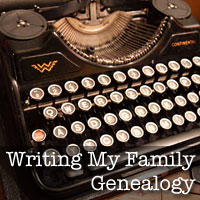Writing My Family Genealogy ~ The Tools

The last time I blogged about writing my family genealogy, I discussed the process of determining the content and format of the book. I touched a little on the tools I’ve tried, but not specifics of what applications I’ve used. So, let’s talk tools.
Genealogy Program
Christopher Fritz posted an article on using Gramps, his genealogy software of choice, to write his book. I’ve never used Gramps, so I can’t speak to its abilities. I use Reunion and I thought about using it to generate the book. I even went so far as to include the content for each person from A German-American Hacker-Hocker Genealogy in their record. I, then, created a “Register Report” and included the specific fields and notes that I wanted in the book.
The resulting report included the information I wanted and numbered everyone correctly, but I had several issues. First, there were formatting problems. It’s a register report, so it used the Register Style for a numbering system. I want to use the NGSQ style. Major problem! Also, it included the source information as endnotes, not footnotes.
Also, I include the facts regarding an ancestor—as I find them—in Reunion, not just my conclusions. This means that I may have multiple entries for date of birth or death. Including all this detail is unnecessary and potentially confusing to readers. I just want to tell the story as I’ve deduced it from my research.
Additionally, I think the text generated in the report is stilted and repetitive. But, more importantly, I find it nearly impossible to write a narrative in my genealogy program. It just doesn’t work for me.
Word Processors
My next step was to move to a word processor—Microsoft Word. It’s a powerful tool and can do just about everything I need—with the exception of NGSQ style numbering for lists within lists. The problem I had with it was that it was too powerful.
Word has so many features, it can be difficult to figure out how to use. And when I used the more advanced feature of “master documents” to manage my large, unwieldy, and difficult-to-find-anything document, I found it difficult to come back to the manuscript after any time away from it, because I would have to figure out how to use it all over again before I could start writing!
I, then, turned to a writing tool I’d used for creative writing—Scrivener. This software was designed for writers and makes it really, really easy to organize chapters, sub-chapters and so on. It’s even easy to re-organize chapters. But, while I love Scrivener, I found that for this project, I need to see the document in it’s correct format while I write. Scrivener is for writing books, not formatting content.
So, I moved on to Apple’s Pages. It’s a simplified word processor. It doesn’t have the features or power of Microsoft Word—doesn’t even do indexing, but it allows me to easily format the content as I write. So far I’m satisfied with it’s abilities. I’m not overwhelmed with options and I can do what I need to do. And at 218 pages, the book hasn’t yet become too unwieldy.
At some point I will need to transfer the manuscript back into Microsoft Word for some final formatting. An ebook or PDF version will be fine without an index because the reader can easily search for a specific name or place. However, an index is a must-have for a printed book. Word is the only program I have where I can create one from the manuscript.
I didn’t go into detail on what any of these programs can and can’t do. If you’re interested in learning more about any of them, leave a comment and I’ll write a more detailed post on that program.
Cite This Page:
Kris Hocker, "Writing My Family Genealogy ~ The Tools," A Pennsylvania Dutch Genealogy, the genealogy & family research site of Kris Hocker, modified 24 Oct 2012 (https://www.krishocker.com/writing-my-family-genealogy-the-tools/ : accessed 25 Apr 2025).
Content copyright © 2012 Kris Hocker. Please do not copy without prior permission, attribution, and link back to this page.
